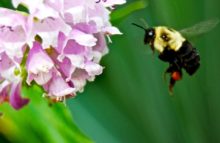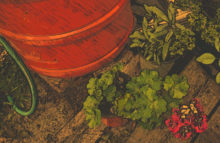Okay, the picture exaggerates. But today we’ll get a taste of it, and tomorrow’s forecast is 30˚C and full sunshine.
Sudden summer, indeed. Expect your new plants to go into mild to moderate shock till they acclimatize. Bye bye, last of the tulips. Oops, there go the apple blossoms. Many spring flowers will move into acceleration mode. Some will get a sunburn.
On hot days like tomorrow, it’s smart to get a jump on watering — particularly anything planted in containers, which heat up and dry out quickly, especially in sunny locations. Here are some tips for tomorrow and all those welcome sunny days ahead.
Water early in the morning. This protects plants from the drying sun, and gives leaves time to dry off. Lingering damp can foster fungus or mildew.
Deep, infrequent watering is better than frequent light sprinkles. It encourages deep root growth, which makes your plants hardier. Shallow watering keeps the roots near the soil surface where they are most likely to dry out.
Water selectively. For example, just carry a bucket of water over to the newly planted rose bush once a week, if everything else is drought-resistant. If you don’t have a rainbarrel yet, this is the time to be thinking of one.
Water from below the foliage if you can. A soaker hose, for instance, snakes permanently around your garden beds and slowly trickles water into the soil at root level. This reduces wasted water, such as from fan sprinklers, and sends the water down deep. However, and this is a big however, you must remember to turn it off. Out of sight can be out of mind. A timer for your soaker hose is a good investment.
Mulch to conserve moisture. Mulching helps keep the root zone cooler and moister. It also introduces organic matter into the soil to add nutrients and improve soil tilth or composition. There are many choices. Compost. Wood chips. (I like the finely shredded black cedar, which looks like natural soil.) Shredded leaves. Whatever works in your garden. Even pea gravel — although this won’t do much to improve the soil.
If you use cocoa bean husks, be careful if your cat or dog is the kind to eat large quantities of this (briefly) chocolate-scented by-product of chocolate making. This has been linked to illness and, in very rare cases, death due to residual theobromine in the husks. This article from the American Veterinary Medical Association puts it into perspective, however. The AVMA bottom line: the risk is low, but be cautious if your pet is the uncontrollably munchy kind. (I have used this mulch many times with no ill effects to my cat. I stopped because it can be more expensive and harder to find than other mulches, and can develop a surface mold in hot, humid weather.)
The best advice, though maybe too late for many of us, is to choose drought-resistant plants. This practice, called xeriscaping, is and probably will continue to be, a growing trend.
I xeriscape in a benign way under the maples in my front garden, as I usually neglect to water it, simply letting the plants duke it out. Anything that survives gets to stay. This strategy has produced a number of successes and, of course, many failures.
I’ll tell you about my burning bush “sculpture” another time.





3 comments
very good post! Great info!
I love your dry earth picture. It looks like an Andy Goldsworthy piece. Beautiful.
All good common sense advice